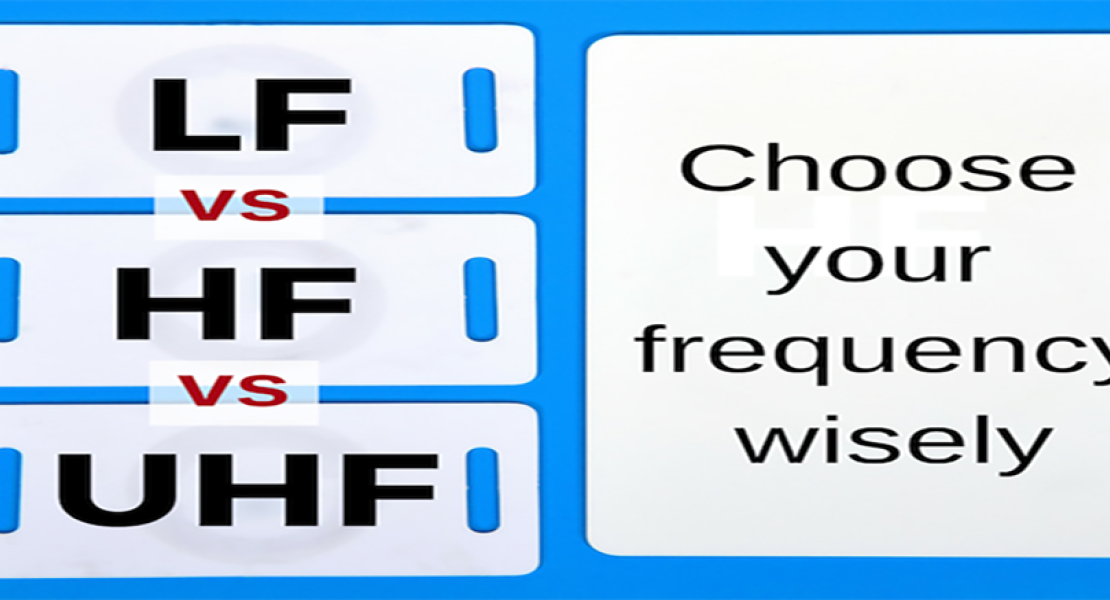When choosing an RFID tag, one important but not-often-thought-of decision to make is the frequency of the tag, such as LF, HF or UHF.
Which do you choose?
- low frequency (LF, 30 KHz to 300 kHz; typically LF systems work at 125 KHz)
- high frequency (HF, 3 to 30 MHz; typically HF systems work at 13.56 MHz) or
- ultra high frequency (UHF, 300 MHZ to 3 GHz; UHF Gen2 standard systems utilize the 860 to 960 MHz band)

LF, HF, UHF Frequencies Each Have Advantages
Both LF and HF frequencies are on the lower end of the RFID electromagnetic spectrum, which indicates RFID tags in these frequencies will have relatively short read ranges but a greater ability to be received or transmitted in all directions.
They also have better operational success in moist conditions, albeit slower transmissions under all conditions. Both have the ability to work in environments involving metal, often with tag modification.
This being said, low-frequency RFID transmission can activate tags behind thin metal substances whereas high-frequency RFID works with tags on metal surfaces - the preposition makes a subtle, but significant, difference.
For example, in a grocer’s meat case, an LF reader can read a ham’s LF RFID tag behind aluminum foil; an HF reader would need the HF RFID tag on the outside of the foil to be read.
Both frequencies, LF and HF, can be used in moist situations where higher frequencies such as UHF stumble for reads. Nevertheless, LF has the advantage over HF when working with moisture.
Take, for instance, an LF RFID chipped cat (mostly made up of water) would use a feeder equipped with an LF RFID reader to access food. Although the cat would probably obtain access control to nourishment under either frequency, the LF feeder would be slightly more dependable and LF tags would be less expensive than HF.
The cat’s LF RFID device, of course, would be close to the reader because LF read range is limited to centimeters or inches.
Most commonly, low frequency tags are used for access control and animal identification.
Likewise, if RFID enabled, the tiny labels on fruit would show benefit from low frequency tagging read by handheld readers that come close to the produce.
In this case, produce management accurately measures quality and quantity for better economic control, but might entail more manual labor.
However, where proximity-to-read is more than a pinky finger away, HF (high-frequency) tags and readers with a transmission/read range up to a yard might be the better choice for produce handlers even if slightly less accurate.
Reads could be made approximately a yard away leading, perhaps, to installation of a shelf RFID management system.
Understand Tag's Purpose Before Choosing RFID Frequency
As always, when using RFID tags, purposes and environments must fit the established - or the soon-to-be-established - RFID system, including the readers, tags, cables and antennas within the system.
Before installing the system, management must take a mental inventory about what it needs to know, which is more than just the application it hopes to achieve.
Read range is one determining factor of RFID tag and system selection. Progressively, HF tags increase read range over LF tags. UHF tags increase read range even further. Some UHF tags will read up to 50 feet depending on tag type (active, passive), the environment and the RFID system in which they are used. Passive and active tags are available in all three frequencies, but passive tags account for approximately three-fourths of the tags sold today. Tag type makes a difference in reads.
Data transfer speed also is a consideration in tag and system selection. Again, progressively, LF, HF, and UHF increase in the speed at which they deliver data. Theoretically, UHF Active Tags have the ability to be read at 1000 tags per minute, but the practicality is questionable, especially in terms of accuracy.
Additionally affecting use, the frequency space in which UHF waves operate is crowded. Transmission collision can occur since cell phones, Wi-Fi, and Bluetooth devices also occupy the same bandwidth on the electromagnetic/radio spectrum.
Also causing transmission problems, the shorter wavelength of UHF can be weakened in the presence of fluorescent lightening and large machinery use as well as the aforementioned metal and moisture obstacles.
Trend Is Toward RFID UHF Frequency
Nevertheless, the trend is toward the use of UHF because UHF tags typically are more affordable, have better read ranges, faster data transfer, and application adaptability for many uses.
Specifically attractive to buyers is the passive UHF tag, which generates its own power and still gives viable, long range reads.
Where HF tags have more tag memory and are most often used for security and identification in credentialing (event admission: laundry, pharmaceutical and book identification, building access and payments), UHF has more potential.
In the realms of logistic and supply chain management, it shines. UHF tags, like Metalcraft's RFID windshield tags, often are used in toll collection, parking control and racing where time-marking is crucial.
It also is becoming prevalent in airline baggage tracking, container tracking, truck and trailer tracking coupled with fleet. Similarly, waste is more easily managed.
As well as being used in transit, UHF tags like Metalcraft's Standard RFID tag or Flex Hard Tag or Stick & Staple RFID tag, are used on docks, in warehouses and on showroom floors: the contents of pallets and cases is easily scrutinized and tabulated using UHF.
Some companies are now even mandating it. The accuracy of the accounting in all realms is unmatched by manual inspection and tabulation, but the real payoff is the speed in which RFID work is done: work that is done in what users call “real time.”
Additionally, UHF tags (especially passive tags) are being continually re-imagined in chip and antenna design, making previous drawbacks a thing of the past. In tag manufacturing, printing the tag antenna and the integrated circuit with conductive ink is a relatively new innovation.
Granted, UHF does have a few pitfalls, but when a system is designed, installed and tested by professional contractors who have knowledge of tag materials, antenna tuning, and the like, any potential pitfalls can be mitigated.
This being the case, once again, the client for RFID tags and RFID systems must take a considered look at needs and costs before purchasing. To talk with a Metalcraft ID specialist or to request a quote call 800-437-5283, 641-423-9460, visit www.universalrfid.com or email us at [email protected].
 | About the Author: Marianne AlvaradoMarianne Alvarado is our Vice President of Sales. Alvarado joined Metalcraft in March of 2000 as a Territory Specialist, became Sales Manager in January 2022 and was named Vice President of Sales during August of 2023. She leads both the Outside and Inside Sales teams. Marianne lives in Davenport with her husband, Dave Beeman. Mobile Phone: 641-529-9492 Email: [email protected] Office: 3360 9th St. SW, Mason City, IA 50401 Office Phone: 641-423-9460 |




